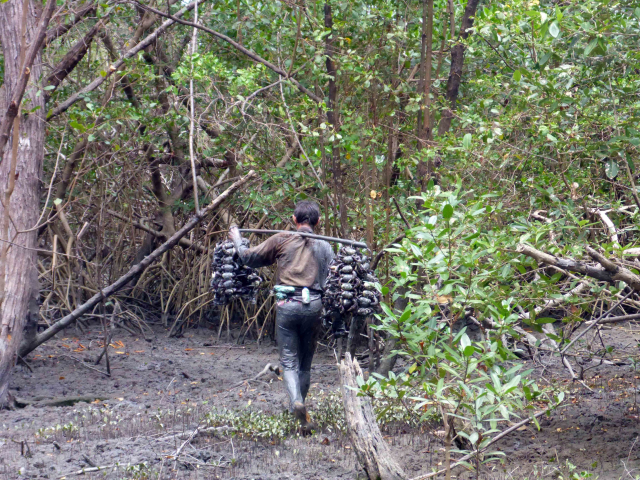18/11/2020 | Mangrove forests support millions of coastal fishers, and a new study has not only highlighted this importance but mapped how this fishing is spread around the world. World-wide, 38% of all small-scale fishers in over 100 countries fish in the mangroves and their adjacent waters. Their fishing provides critical food security for them and for many millions more who depend on them for food or work, including some of the world’s most vulnerable communities.
An international group of mangrove experts, representing fisheries knowledge from 11 nations and including Prof. Matthias Wolff and Gustavo Castellanos-Galindo, fisheries biologists at the Leibniz Centre for Tropical Marine Research (ZMT), have worked together to develop a global model of fishing intensity in mangroves. This new analysis estimates that there are 4.1 million small scale fishers across 109 countries and territories participating in subsistence, small-scale, and near-shore commercial fisheries.
The largest number of fishers were found in Indonesia, India, Bangladesh, Myanmar and Brazil, countries with large expanses of mangroves. However, the proportion of coastal fishers reliant on mangroves is even higher in some other countries, notably in West and Central Africa but also along the Pacific shores of Ecuador and Colombia.
The model suggested not only that many fishers use mangroves, but also that some areas of mangroves are subject to very high fishing intensity. Countries such as India, Vietnam and China have some of the highest mangrove fishing intensities.
Mangroves are coastal and estuarine forests at the transition between land and sea. Their function as a habitat and nursery for countless species of fish, crustaceans and other marine life is of enormous value to coastal dwellers. Mangrove forests have been subjected to massive losses through conversion to aquaculture ponds, and to urban and agricultural uses.
The cost of their losses in terms of livelihood and food security for many of the most vulnerable coastal communities has never been properly calculated. But the new study highlights the risk and aims to help persuade governments and local communities to do more to protect and restore these valuable ecosystems.
Publication
Philine S.E. zu Ermgassen, Nibedita Mukherjee, Thomas A. Worthington, Alejandro Acosta, Ana Rosa da Rocha Araujo, Christine M. Beitl, Gustavo A. Castellanos-Galindo, Marília Cunha-Lignon, Farid Dahdouh-Guebas, Karen Diele, Cara L. Parrett, Patrick G. Dwyer, Jonathan R. Gair, Andrew Frederick Johnson, Baraka Kuguru, Aaron Savio Lobo, Neil Loneragan, Kate Longley-Wood, Jocemar Tomasino Mendonça, Jan-Olaf Meynecke, Roland Nathan Mandal, Cosmas Nzaka Munga, Borja G. Reguero, Patrik Rönnbäck, Julia Thorley, Matthias Wolff, Mark Spalding. Fishers who rely on mangroves: Modelling and mapping the global intensity of mangrove-associated fisheries. Estuarine, Coastal and Shelf Science, 2020, 106975, https://doi.org/10.1016/j.ecss.2020.106975.





